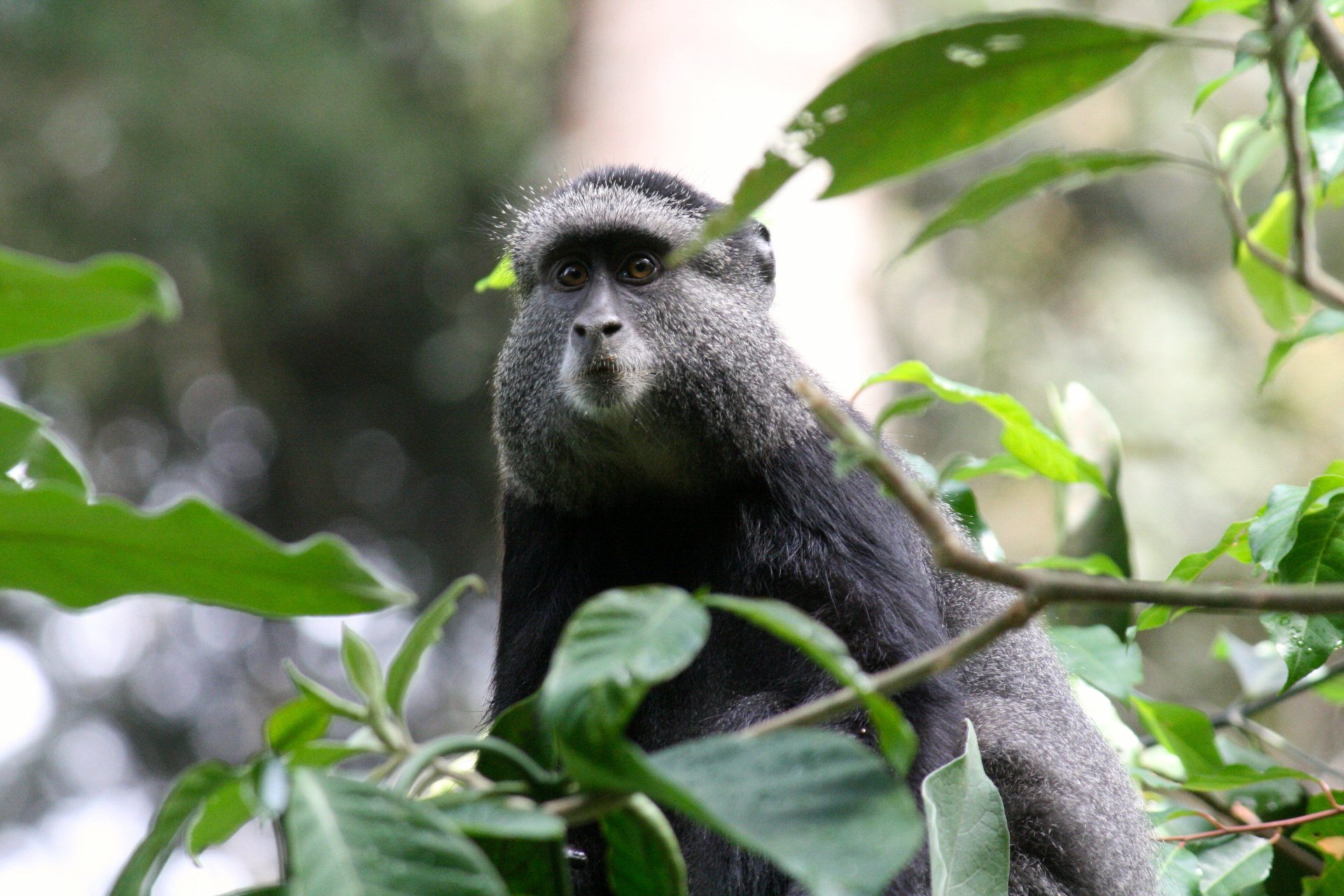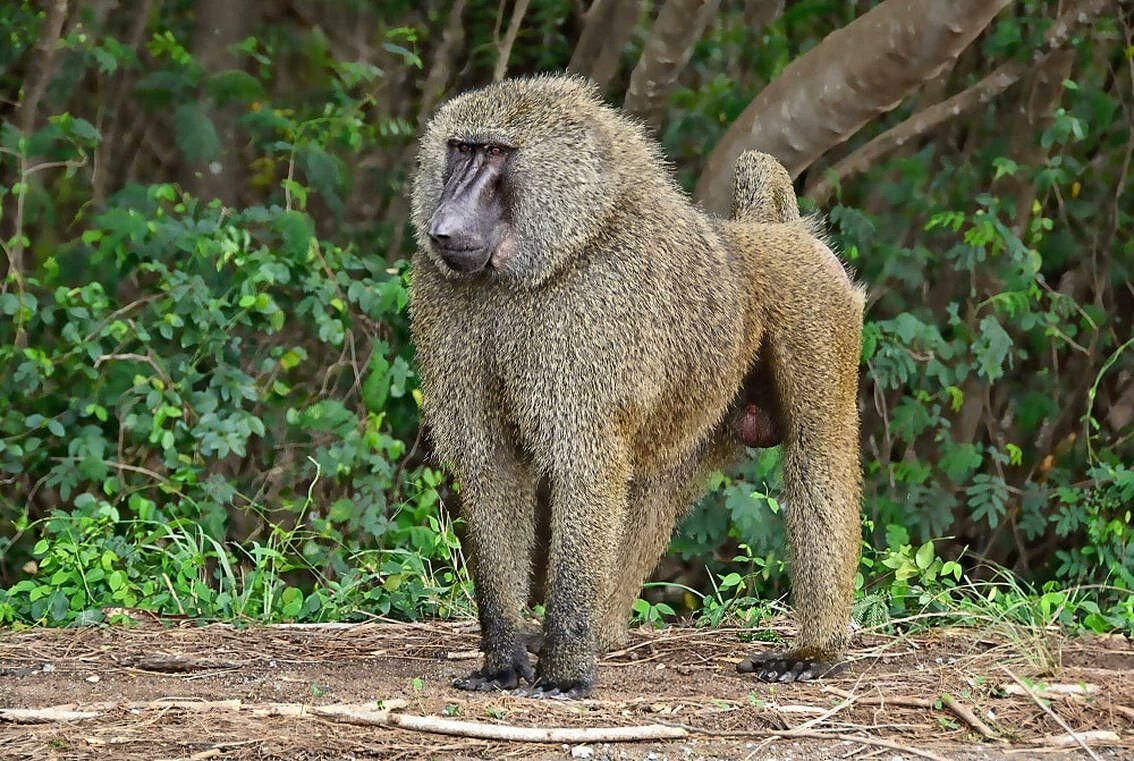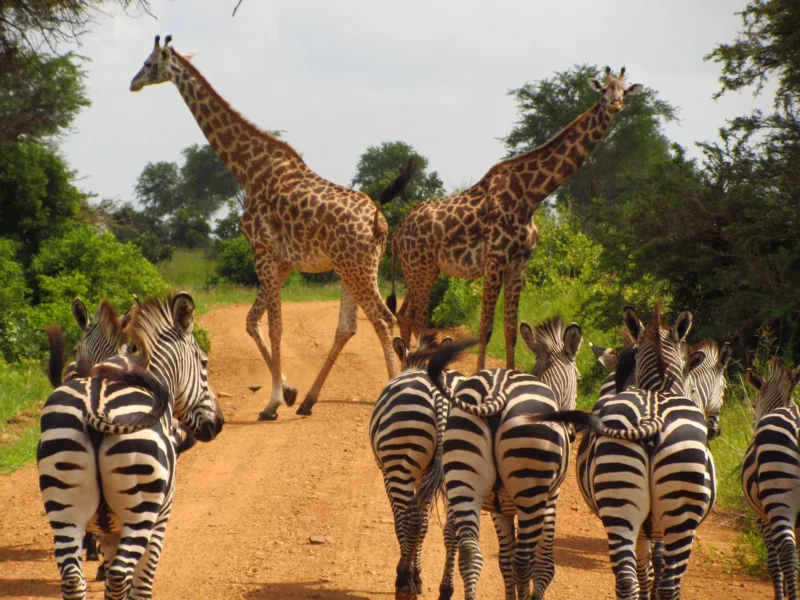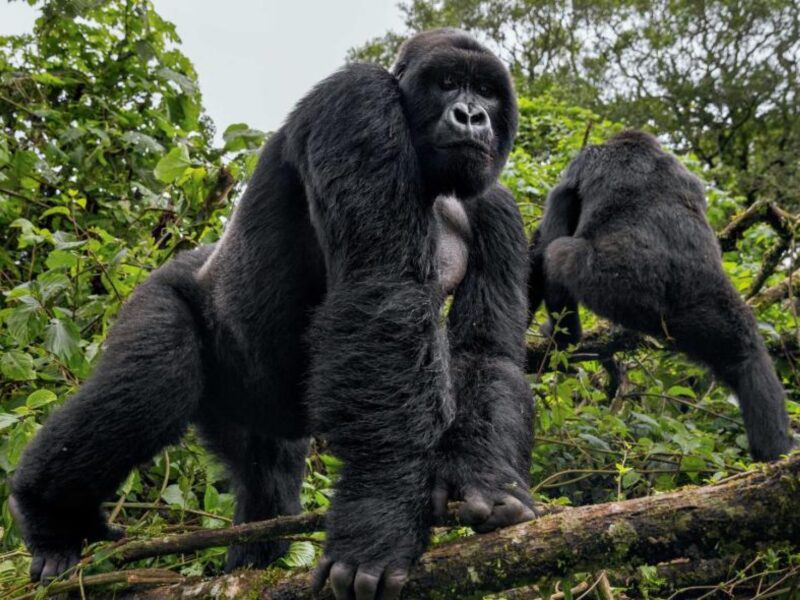
Ruaha National Park Tanzania
April 11, 2025
The Ugandan Blue Monkey
April 11, 2025Ugandan Baboon
Baboons are amazing primates, widely distributed across the country, and play a significant role in Uganda’s wildlife and ecosystems. Uganda is home to two species of baboons: the Yellow baboon (Papio cynocephalus) and the Olive baboon (Papio anubis). These baboons are important not only ecologically but also culturally and in the context of wildlife tourism. Here’s a detailed look at baboons in Uganda:
1. Species of Baboons in Uganda:
Yellow Baboon (Papio cynocephalus):
The Yellow Baboon (Papio cynocephalus) is one of the two baboon species found in Uganda, and it is particularly known for its striking physical appearance and fascinating social behaviors. These baboons are widely distributed in various parts of Uganda, playing a significant role in the ecosystem and wildlife tourism. Here’s a detailed overview of the Yellow Baboon in Uganda:
Habitat and Distribution:
-Habitat: Yellow baboons are typically found in savannahs, woodlands, and grasslands in Uganda. They prefer open, dry areas with a mix of forested zones and more open land for foraging. They are most commonly seen in protected areas, including Kibale National Park, Queen Elizabeth National Park, and Lake Mburo National Park.
-Distribution: This species is found throughout Uganda, though it is more common in the western and southern parts of the country. They thrive in areas where there are ample food sources, water, and suitable trees for sleeping or escaping predators.
Physical Description:
– Size: Yellow baboons are large primates. Adult males typically weigh between 30-45 kg (66-99 lbs), and females are smaller, usually weighing between 12-20 kg (26-44 lbs).
-Coat: The most distinctive feature of the Yellow Baboon is its light yellowish-brown fur, which gives the species its name. Their fur color may appear a bit different depending on the environment, but the yellowish-brown coat is most prominent.
-Face and Muzzle: Their faces are characterized by a long, pale-colored muzzle, and they have sharp canine teeth that are used for social interactions and feeding. The light-colored face contrasts with the darker fur on their bodies and rumps.
-Eyes and Expression: Yellow baboons have large, expressive eyes that contribute to their communication, social bonding, and overall interaction within the troop. Their facial expressions play a significant role in signaling emotions such as aggression, submission, or affection.
-Tail: They have a long non-prehensile tail, which aids in maintaining balance when moving quickly on the ground or climbing trees.
Behavior and Social Structure:
-Social Structure: Yellow baboons are highly social and live in large troops. These troops can range in size from 20 to 100 individuals, depending on the availability of food and resources. A typical troop includes a mix of males, females, and infants, all with well-defined social roles.
-Males: The troop is usually led by an alpha male, who dominates the group and has priority access to mating opportunities. Male baboons often compete for leadership positions, and there can be challenges between dominant males for control.
-Females: Female baboons typically form the core of the troop and have strong bonds with one
another. Matrilineal relationships are common, meaning that female baboons often remain in the same troop throughout their lives, while males tend to move between groups.
– Hierarchy and Dominance: The hierarchy within the troop is primarily based on dominance. Females often maintain long-term relationships with their family members, whereas males may change groups as they mature or seek to challenge higher-ranking males.
-Communication: Yellow baboons communicate through a variety of methods, including vocalizations, facial expressions, and body language. They are known for their loud barking calls, especially when alarmed, but also use grunts, screams, and squeals to express emotions or signal the presence of danger.
– Facial expressions play an important role in signaling aggression or submission. Baboons are also known to bare their teeth in a threatening or dominant manner.
Diet and Feeding:
– Omnivorous Diet: Yellow baboons are omnivores, and their diet is highly varied. They forage in groups and eat a range of foods including:
– Fruits, such as berries and seeds
– Leaves and flowers from trees and plants
– Roots, tubers, and insects
– Small mammals, birds, and their eggs
– Crops (which sometimes brings them into conflict with farmers near national parks).
– Foraging Behavior: Yellow baboons spend a significant portion of their day foraging for food on the ground. They may use their strong jaws and sharp teeth to break open hard fruits or seeds.
– They also employ tools to access food, such as using stones or sticks to crack open nuts or dig for tubers.
Reproduction and Lifespan:
– Mating and Reproduction:
– Female yellow baboons typically reach sexual maturity around 5-7 years. Males mature slightly later, around 8-10 years.
– Yellow baboons do not have a fixed breeding season. Mating occurs throughout the year, and females generally give birth to one infant after a 6-month gestation period.
– The female is responsible for caring for the infant, and the young baboon will stay with its mother for an extended period, learning social behaviors and foraging techniques.
– Lifespan: Yellow baboons can live up to 45 years in captivity, but in the wild, their lifespan is generally shorter due to predation, disease, and other natural threats.
Predators and Threats:
– Predators: The primary predators of yellow baboons include lions, leopards, hyenas, and crocodiles. Their large social groups act as a defense mechanism, allowing them to stay alert and warn each other of approaching threats.
– Human-Wildlife Conflict: In areas like Queen Elizabeth National Park and Kibale National Park, yellow baboons sometimes raid crops or food stores in nearby human settlements, leading to conflicts with local farmers.
– Conservation Status: While the yellow baboon is not currently listed as endangered, it faces threats from habitat loss, human-wildlife conflict, and poaching. However, its population is still considered stable due to its widespread distribution and adaptability.
Baboons in Tourism:
-Wildlife Viewing: Yellow baboons are easily spotted in several of Uganda’s national parks, including Queen Elizabeth, Kibale, and Lake Mburo National Park. Visitors often see them foraging in the open or moving through the trees.
– Their social dynamics and interactions within the troop make them an interesting species to observe, especially for tourists keen on primate behavior.
– Tourism and Ecotourism: As part of Uganda’s rich wildlife tourism offerings, baboons, including the yellow baboon, add to the diversity of experiences in Uganda’s national parks. Their role in the ecosystem as omnivores and social primates provides tourists with insight into the balance of nature.
Cultural Importance:
– While the yellow baboon does not hold the same specific cultural importance as some other species like gorillas or chimpanzees, they are still part of the broader Ugandan wildlife heritage and are appreciated for their role in maintaining ecological balance.
Conclusion:
The Yellow Baboon is a fascinating species found in Uganda’s savannahs, woodlands, and grasslands. Known for its social structure, intelligence, and adaptability, the yellow baboon plays an essential role in the country’s ecosystems. It is a popular species for wildlife tourists and provides an important example of primate behavior and ecological balance. While not facing immediate conservation threats, its relationship with humans, particularly in terms of crop-raiding, remains an area of concern. Nonetheless, the yellow baboon remains one of Uganda’s iconic and captivating primates.
2 Olive Baboon (Papio anubis):
The Olive Baboon (Papio anubis) is the most widespread baboon species in Uganda and across sub-Saharan Africa. Known for its intelligence, adaptability, and complex social behavior, the olive baboon plays a vital role in Uganda’s ecosystems and wildlife tourism. This large and highly social primate is commonly seen in Uganda’s national parks and forested regions, and it’s easily recognized by its olive-colored coat and expressive face.
Habitat and Distribution:
– Range in Uganda: Olive baboons are found in almost all major protected areas, including:
– Murchison Falls National Park
– Kibale National Park
– Queen Elizabeth National Park
– Lake Mburo National Park
– Bwindi Impenetrable Forest edges
– Habitat Types: They thrive in a wide variety of environments:
– Savannahs
– Woodlands
– Forests
– Riversides and mountain slopes
Their wide habitat tolerance allows them to adapt easily to human-modified landscapes, which sometimes leads to crop-raiding and conflict with nearby communities.
Physical Description:
Size:
– Adult Males: 24–45 kg (53–99 lbs), up to 70 cm tall at the shoulder
– Females: Smaller, around 14–25 kg (31–55 lbs)
Fur: Olive baboons have a thick, coarse coat that appears greenish-grey or olive due to the combination of black and yellowish hairs.
Face:
– Dark, hairless muzzle with pronounced brow ridges
– Long, dog-like snout with large canine teeth, especially in males
Tail:
– Bent shape with an upward kink at the base before hanging down
– Not prehensile, used for balance
– Distinct Features:
– Large, expressive eyes
– Sexual dimorphism:
Males are significantly larger with more muscular builds and manes of longer fur around the neck and shoulders.
Social Structure and Behavior:-
Troop Size: Typically ranges from 20 to 150 individuals.
– Group Composition:
– Multi-male, multi-female groups
– Strong female bonds (matrilineal structure)
– Males change troops during adolescence
– Dominance Hierarchies:
– Clear male dominance hierarchy; dominant males get better access to females
– Female rank is inherited and stable; daughters follow their mother’s social status
– Communication:
– Use vocalizations, gestures, facial expressions, and body postures
– Alarm barks, grunts, screams, and teeth displays are common
– Grooming is a key social activity, used to maintain bonds and reduce tension
Diet and Feeding:
– Omnivorous and highly opportunistic feeders
– Main foods:
– Fruits, seeds, grasses, roots
– Insects, small reptiles, birds
– Eggs, small mammals, and even newborn antelopes or monkeys
– Known to raid farms for crops like maize, bananas, and cassava
– Highly adaptable foragers that exploit both wild and human food sources
Reproduction and Lifecycle:
– Breeding: Year-round (no fixed season)
– Gestation: About 6 months
– Offspring: Usually a single infant, occasionally twins
– Infant Care:
– Infants cling to their mother’s belly, then ride on her back as they grow
– Mothers are protective and nurturing; juveniles stay close for up to 2 years
– Lifespan:
– 20–30 years in the wild
– Can live up to 45 years in captivity
Predators and Threats:
– Natural Predators:
– Lions, leopards, hyenas, crocodiles, and large birds of prey (for infants)
– Defensive Strategies:
– Large troops offer safety in numbers
– Males defend the group by displaying aggression or even attacking predators
– Human-Wildlife Conflict:
– Frequent crop raiding causes tension with local farmers
– Occasionally killed in retaliation or to protect crops
– Conservation Status:
– Not endangered – listed as Least Concern by the IUCN
– Populations remain stable due to their adaptability and wide range
Olive Baboons and Tourism in Uganda:
– Tourist Hotspots:
– Commonly seen in Murchison Falls, Queen Elizabeth, and Kibale
– Frequently seen by roadsides, interacting with vehicles
– Attractions:
– Fascinate tourists with their intelligence, curiosity, and group dynamics
– Sometimes mischievous – known to steal food or inspect tourist vehicles
– Educational Value:
– Used in primate tracking experiences and educational safaris
– Great examples of primate social complexity and adaptive behavior
Cultural and Ecological Importance:
– Ecological Role:
– Help with seed dispersal
– Regulate prey species like insects and small mammals
– Cultural View:
– Often seen as tricksters or nuisances due to crop theft
– In some local folklore, baboons are thought to be clever and sneaky
– Despite conflicts, they are recognized as part of Uganda’s natural heritage
visual comparison between Olive and Yellow Baboons,
Physical Description:
– Size: Both species of baboons are large primates. Adult males can weigh between 30-45 kg (66-99 lbs), while females are usually smaller, weighing between 12-20 kg (26-44 lbs).
– Face and Muzzle: Baboons are known for their long, prominent muzzles and sharp canine teeth, used in both feeding and social interactions.
– Tail: Baboons have long, non-prehensile tails, which are used for balance, especially when moving quickly on the ground or in trees.
– Social Features: Their large eyes and expressive faces contribute to their social communication, which plays a vital role in their group dynamics.
Behavior and Social Structure:
– Social Structure: Baboons are highly social animals that live in large troops led by an alpha male. The troops can range from a few individuals to hundreds depending on the resources and space available. The hierarchy within the troop is established through social bonds, grooming, and sometimes aggressive encounters.
– Troop Dynamics:
– Female baboons are usually the core of the troop and have lifelong relationships with their family members. They tend to stay in the same troop throughout their lives.
– Males, on the other hand, may move between troops, especially when they mature and become rivals for leadership positions. The males have a strict dominance hierarchy, with the highest-ranking male enjoying priority access to mating opportunities.
– Communication:
Baboons communicate using a variety of vocalizations, facial expressions, and body language.
They are known for their loud barking calls when alarmed, but they also use grunts, screams, and squeals to express emotions and interact with troop members.
– Facial expressions play an important role in communication, with baboons often baring their teeth to signal aggression or to establish dominance.
– Foraging and Diet: Baboons are omnivorous and have a varied diet that includes fruits, seeds, roots, insects, small mammals, and birds. They are known to forage in groups, and they often use stones or tools to break open hard nuts or seeds.
– In some cases, they have been observed hunting small animals like baby gazelles or rodents.
– Habitat Use: While baboons spend much of their time on the ground, foraging and moving, they also climb trees to escape predators or to sleep at night. Their ability to move between the ground and trees gives them flexibility in terms of habitat choice.
Reproduction and Lifespan:
– Mating: Female baboons reach sexual maturity around 5 to 7 years, and males typically mature around 8 to 10 years. Baboons do not have a fixed mating season, so they may reproduce year-round. Females generally give birth to one infant after a 6-month gestation period.
-Offspring Care: Once born, a baby baboon is carried by its mother for several months, with close maternal care. The young baboon stays with its mother for a long period, learning social behaviors and foraging techniques.
-Lifespan: In the wild, baboons can live up to 45 years in captivity, but their lifespan in the wild is typically less due to predation, disease, and competition for resources.
Predators and Threats:
– Predators: Baboons face threats from larger predators like lions, leopards, and hyenas. They also need to be cautious of crocodiles when crossing rivers. To protect themselves, baboons use their keen sense of hearing and vigilant group dynamics to stay alert and avoid danger.
-Human-Wildlife Conflict: Baboons sometimes come into conflict with humans, especially in areas where they raid crops or food stores. In Uganda, this has been an issue in agricultural zones, especially in national parks like Queen Elizabeth National Park and Kibale National Park.
– Conservation Status: While baboons are not currently endangered, habitat loss, human-wildlife conflict, and poaching for the illegal wildlife trade can affect their populations in certain areas. They are, however, considered to have a stable population overall.
6. Baboons in Tourism:
-Wildlife Viewing: Baboons are one of the most common wildlife species encountered in Uganda’s national parks. Visitors to places like Queen Elizabeth, Murchison Falls, Kibale, and Lake Mburo National Park often see baboons during their safaris. They are usually found foraging on the ground or moving through trees.
-Tourism Impact: As one of the “Big Five” primates in Uganda (along with gorillas, chimpanzees, monkeys, and elephants), baboons are part of the broader tourism appeal that brings visitors to Uganda’s wildlife parks. Their social behavior and interaction with other animals make them an exciting species for tourists to observe.
-Educational Value: The presence of baboons adds significant educational value to safaris, as they are a great example of complex primate social structures and intelligent behaviors. Visitors learn about their interactions, communication methods, and importance in the ecosystem.
Conclusion:
Baboons are an important and charismatic species in Uganda’s wildlife landscape. As highly social and intelligent primates, they contribute to the biodiversity of Uganda’s national parks and are an integral part of both the ecosystem and tourism industry. Whether observed for their social dynamics, their impressive adaptability, or their role in maintaining the balance of their environment, baboons are fascinating creatures to study and observe




